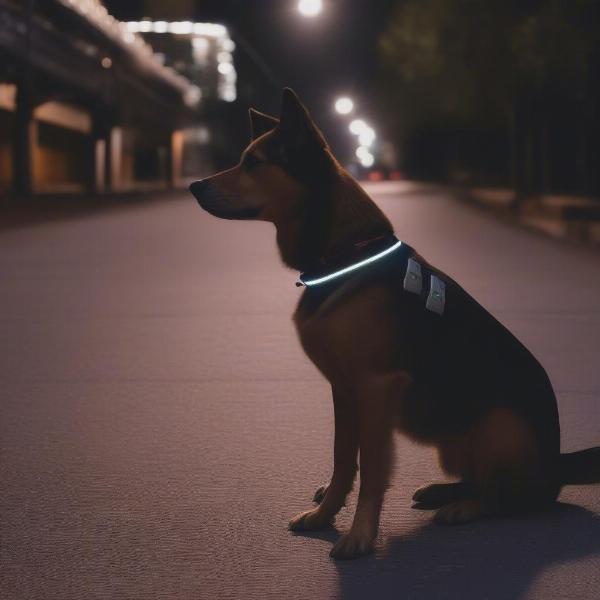Collars for dogs are an essential part of dog ownership, serving as identification, a point of control during walks, and a fashion statement. This comprehensive guide will help you understand the different types of collars available, how to choose the right one for your dog, and ensure a comfortable and safe fit.
Types of Dog Collars
Choosing the right collar can be overwhelming with so many options available. Here are some common types:
- Flat Collar: The most basic type, usually made of nylon, leather, or fabric. Ideal for everyday use and displaying ID tags.
- Martingale Collar: Designed to tighten slightly when pulled, preventing escape. A good choice for dogs who tend to slip out of their collars.
- Choke Chain/Slip Collar: Controversial collars that tighten around the dog’s neck when pulled. Not recommended for inexperienced owners due to the risk of injury.
- Prong Collar: Another controversial type with metal prongs that dig into the dog’s neck when pulled. Should only be used under the guidance of a professional dog trainer, if at all.
- Harness: Not technically a collar, but a popular alternative for walking dogs, especially those who pull or have respiratory issues. Distributes pressure across the chest and shoulders.
- Head Halter: Resembles a horse halter and controls the dog’s head. Useful for training and managing reactive dogs.
How to Choose the Right Collar
Choosing the right collar depends on several factors:
- Your Dog’s Breed and Size: A small dog will need a smaller, lighter collar than a large breed. Certain breeds with thick necks may benefit from wider collars.
- Your Dog’s Temperament: A dog who pulls excessively may need a martingale collar or a harness. A shy or nervous dog may do best with a flat collar.
- Your Training Goals: If you’re focusing on training, a flat collar or head halter may be suitable.
- Your Dog’s Health: Dogs with breathing problems should avoid collars that put pressure on the trachea.
Ensuring a Proper Fit
A properly fitted collar is crucial for your dog’s comfort and safety. A general rule is to be able to fit two fingers between the collar and your dog’s neck. Too tight, and it can restrict breathing; too loose, and your dog can slip out.
Caring for Your Dog’s Collar
Regularly check the collar for wear and tear. Clean it according to the manufacturer’s instructions. Leather collars may require conditioning to prevent cracking.
Beyond the Basics: Collars for Specific Purposes
Beyond everyday collars, there are specialized collars available:
- GPS Collars: Track your dog’s location, providing peace of mind for adventurous pups.
- Bark Collars: Designed to deter excessive barking, using various methods like vibration or sound. Choose carefully and consider the potential impact on your dog’s well-being.
- Reflective Collars: Increase visibility during nighttime walks, enhancing safety.
 GPS and Reflective Collars for Dogs
GPS and Reflective Collars for Dogs
Conclusion
Selecting the right collar for dogs involves understanding your dog’s individual needs and the different collar types available. Prioritize comfort, safety, and functionality to ensure your furry friend has the best collar for their lifestyle.
FAQ
- How often should I check my dog’s collar? Check your dog’s collar regularly, at least weekly, for any signs of wear and tear.
- Can I leave a choke chain on my dog unsupervised? Never leave a choke chain on a dog unsupervised, as they can become entangled and cause injury.
- What’s the best collar for a puppy? A lightweight, adjustable flat collar is typically best for a puppy.
- My dog pulls a lot, what type of collar should I use? Consider a harness or a martingale collar for dogs who pull excessively.
- Are prong collars safe? Prong collars are controversial and can cause harm if used incorrectly. Consult with a professional trainer before using one.
- How tight should a dog’s collar be? You should be able to fit two fingers comfortably between the collar and your dog’s neck.
- How do I clean my dog’s collar? Cleaning instructions vary depending on the material. Check the manufacturer’s recommendations.
ILM Dog is your trusted resource for all things dog-related. We offer expert advice on dog breeds, health, training, nutrition, grooming, and much more. Whether you’re a new dog owner or a seasoned pro, we’re here to help you provide the best possible care for your canine companion. For personalized guidance on selecting the perfect collar or any other dog-related questions, contact us at [email protected] or call us at +44 20-3965-8624. ILM Dog is dedicated to helping you navigate the wonderful world of dog ownership.